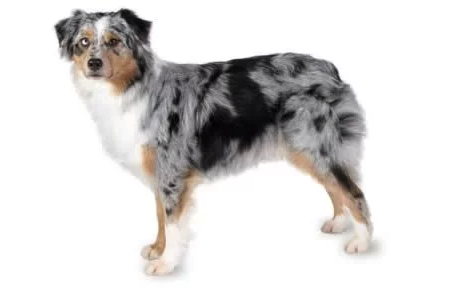Australian Shepherd
Average Size of Male: Weight: 50.71 pounds (23 kg)–63.93 pounds (29 kg) Height: 20.08 inches (51 cm)–22.83 inches (58 cm)
Average Size of Female: Weight: 30.86 pounds (14 kg)–63.93 pounds (29 kg) Height: 18.11 inches (46 cm)–20.87 inches (53 cm)
Lifespan: 12 years–18 years
Major Concerns: Cataracts – blocks light in eye’s iris; coloboma – missing area of the eye’s iris; collie eye anomaly (CEA) – open pits in the eye; canine hip dysplasia – femur does not properly fit in pelvic socket; multidrug resistance 1 gene mutation (MDR1) – sensitive to some drugs; immune mediated hemolytic anemia (IMHA) – low blood count
Minor Concerns: Gastric torsion (bloating)
Occasionally Seen: Epilepsy seizures, osteochondritis dissecans (OCD) – painful elbow and shoulder joints; lumbar sacral syndrome – spinal problem; nasal solar dermatitis – autoimmune disease affecting the outer nose; Pelger-Huet syndrome – abnormal white blood cell development, kills unborn and newborn puppies; Von Willebrand’s disease (vWD) – blood clotting disorder, patent ductus arteriosus (PDA) – heart defect; persistent pupillary membrane (PPM) – tendrils of membrane extending across the eye’s pupil; progressive retinal atrophy (PRA) – eye disease that causes blindness
Brief History of the Australian Shepherd
Despite its name, there is debate over whether the Australian Shepherd actually came from Australia. In the 1800s, vast numbers of Australian sheep were imported to America, and they may have been accompanied by dogs and the Basque shepherds who cared for them. Over time, the dogs were developed in the Western states and were recognized by ranchers for their herding abilities. Photographs from the 1800s and early 1900s will often show these dogs, either at work with the flocks or posing with their hardworking owners.
In the 1950s, performer Jay Sisler developed a trick-dog act starring his Aussies and gleaned recognition as a foundation breeder. Then in 1957, a group of devotees began the Australian Shepherd Club of America. It wasn’t accepted into the American Kennel Club’s herding group until 1993.
Australian Shepherd Breed Appearance
A medium-sized breed of solid build, the Australian Shepherd has a soft double coat that comes in a number of colors. These include black or black and white, tricolor, blue merle or red merle. The dog may have copper or white markings on the face, legs or chest. The dog’s tail is typically docked to a very short length; some Aussies will appear to have no tail at all. The ears are semi-erect, the tips dropping naturally, which gives the dog a sweet and soft expression.
Australian Shepherd Breed Temperament
Born to work, the Australian Shepherd is highly energetic and requires plenty of daily exercise. The dog excels at sports such as disc or agility. His herding instinct is strong and compels him to try to keep pets, livestock or his human family members in order. He is extremely intelligent, playful, and loyal. He is an alert watchdog but not as prone to excessive barking as some of the other herding breeds.
Australian Shepherd Breed Maintenance
The Aussie’s coat requires regular brushing. He will shed profusely in the spring, and then moderately throughout the rest of the year. He needs a significant amount of playtime or training time throughout his life, as he is prone to destructive habits if his busy mind isn’t kept occupied in a constructive way.
Source:
The Australian Shepherd: Aussie Basics
http://theaustralianshepherd.net/wordpress/aussie-basics/origins/

 Toledo, United States.
Toledo, United States.
